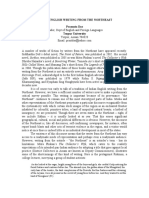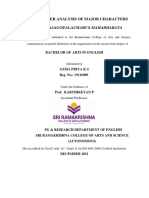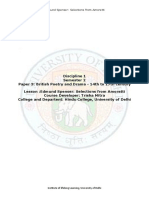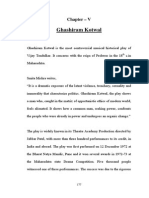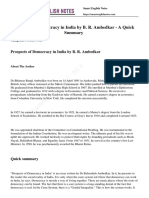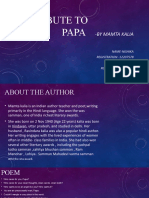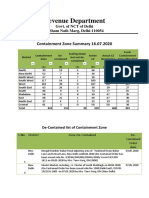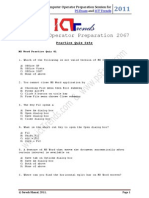Rise of Indian English NovelIt would perhaps be just not a mere overstatement if stated that - literature and history arevery much intimately linked. Literature is known to represent history without anyexaggeration or a biasness of the mind set-up. And history is no better portrayed in Indianliterature than the novels that have been rendered life with much pain, love, affection andrespect. The history of Indian novels is almost the personified flowering of Indian historyitself, that can be elucidated as under.History of Indian novels is grossly and sublimely based upon and interlinked with thedefinition and delineation of the Indian writers, be it in regional or the English language.The modern Indian writers writing in English, have been well-bred and mannered torichly represent the historical incidents and events in their works time and again. Now, itis difficult for a writer to escape the major historical events. Historical events andmomentous happenings are one such domain, which have firstly been mirrored inliterature, mostly through treatises, essays and of course, novels. As such, Indian novelsand its history had begun to already happen since the pre-historic ages, when novelwriting was still very much in its nascent, toddler state. The substantial rise of Indianwriting in English and the novelistic tradition in the English language is a subject matter that had arrived much later, precisely just after the British Raj and consequent IndianIndependence. Leaving out the rise of Hindu ruling dynasties during the ancient to lateancient period, the medieval period, to some extent had witnessed the development of novel and prose writing. However, a considerable historical period for Indian novels wasushered in, a kind of `renaissance` in a rather high-flying sense, with the birth of theIndian Independence movement under the British Empire.As such the Partition of India into two separate countries post Indian Independence andits bloody aftermath had arrested the attention of a major cluster of Indian writers, bringing in the history of novel writing in India towards glorious light and globalaccolade. There has since emerged a host of writers concentrating on history and historyalone. Among the writers of this post Independence `stream of consciousness` and `post-colonialism` genre, umpteen crucial names figure predominantly. These writers havedynamically surveyed the decisive outcomes in the history of India. Three novelistsKhushwant Singh, Manohar Malgonkar and Chaman Nahal have time and again provedthis in their writings. However, history of Indian novels does owe a lot to Bengaliliterature and the sheer brilliant and dazzling writers that had come up during pre-Independent India, in the middle 19th to late 20th centuries. The likes of RabindranathTagore, Ishwar Chandra Vidyasagar, Bankin Chandra Chattopadhay, Sarat ChandraChattopadhay, Tarashankar Bandopadhyay, Bibhutibhushan Bandopadhyay, Manik Bandopadhyay, Bimal Mitra and a little later, Satyajit Ray, have forever been included inthe elite list of Bengali novel writers, superlatively bringing to surface the cultural and political and economical ethos of the then India. The idyllic mixture of fantasy, mystery,non-fiction, fairy tale, science fiction under these `Bangla` men, truly had elevated thestatus of Indian novels in Indian history forever.As to the factual evolvement of Indian novels, it is now known that the historical scenarioof novels in India is conventionally conceived to have come to view in the middle of the
nineteenth century. The year of the Great Revolt of 1857 or the Sepoy Mutiny hadwitnessed the publication of Alaler Gharer Dulal by Peary Chand Mitra (TekchandThakur), upon which Bankim Chandra Chattopadhay, who himself maintains a soaringstatus in the historical development of the novel in India, lavishly had extolled as a"beautifully written" work. The contemporary estimation of the virtues of this work has been rather limited and moderate, but notwithstanding, Alaler Gharer Dulal is conceivedto engage an exceptional position in the history of Indian, and most certainly Bengaliliterature as "the first work in Bengali which can be described as a novel."Just like its English counterpart in the 18th century, in India the novel`s beginnings are believed and imagined to be associated with the `diffusion` of the `market economy` intothe countryside, the clandestine emergence of a bourgeoisie conception and, eventually,the advent of other forces of `modernisation` and `Westernisation`. With theconsolidation of British rule and the changeover of authoritarian power from the EastIndia Company with its fallible ways to the Crown - theoretically the very quintessenceof the `rule of law`, both the rulers and the ruled could commit more concentration to themuch touted moralities of `improvement`, and "life became more settled andconventional". Due to the thus emergence of the bourgeoisie society in the British Indianscenario, history of novel writing in India began to take up pace, with various householdssolemnly making endeavours to make their outcry known to the worldwide populace.In spite of such stellar accounts of the history of novels in India, there still exists greatdeal of room for debate in the `conventional account` of the emergence of the novel in pre-Independent Indian scenario. Life may indeed have become more "settled" with the passing of the Mutiny of 1857-58, to that extent that departures from stated policy wererendered less in the inconsistent manner and the administration had assumed a more evennote. As is said, the post-Sepoy Mutiny period was characterised by the emergence of British ascendency and dominance over the most intimate aspects of the everyday lives of ordinary natives. However `civilised` or `well-mannered` the British Crown had calledthemselves, there was, in the long run, absolutely null use for the Indians in matters of privacy in both familial and commercial issues. And such governance was very much andintegrally visible in the novels that came out in the dark, with British authorities tryingevery motion to curb such publishings in the light of day. As such, with respect to thethesis that the history of the Indian novel owed a good deal to the development of amarket economy, one can hardly question that new forms of commerce arose with theadvent and fanning out of British dominion. Such shrewd modes of mixing art withcommerce had significantly given rise -- especially in the port cities of Bombay, Calcutta,and Madras -- to a whole new class of shipping agents, customs functionaries, middlemenand merchants.Whatever might have been that unseen force of the `sociological explanation` in helpingone comprehends the historical growth of the novel in India, it has also been reasonedthat by the mid-nineteenth century, English novels were widely available in India. Andfor this very fact there exists authenticated testimony of writers like Bankim Chandrahimself. The novels of Walter Scott and Edward Bulwer Lytton may not have been asfervently anticipated in India as they were in the United Kingdom, but they were
nevertheless to leave an indelible mark on the Indian novel and its historical perspective.To place rather concisely, the novel in India must, on the conventional opinion, be an`alien import`.




















